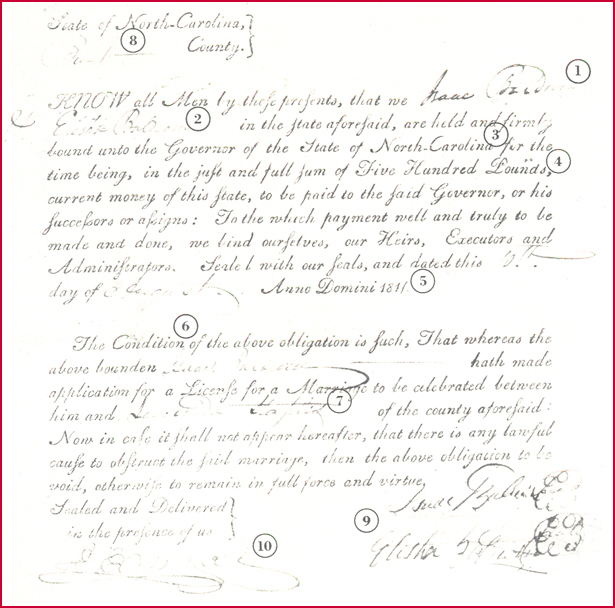
Return to Currituck Co.
![]()
CURRITUCK COUNTY MARRIAGE BOOK A
1850 - 1868

![]()
|
Unnumbered pg. thru 10 (1850 - 1854 & one 1836 marriage) |
|
Pages - 11 thru 20 (1853 - 1855) |
|
Pages 21 thru 30 (1855 - 1856) |
|
Pages 31 thru 40 (1856 - 1857) |
|
Pages 41 thru 50 (1856 - 1859) |
|
Pages 51 thru 60 (1859 - 1861) |
|
Pages 61 thru 67 (1861 - 1865) |
|
Pages 74 thru 80 (1865 - 1866) |
|
Pages 81 thru 87 (1866 - 1868) |
In all the procedure of filing marriage bonds, granting marriage licenses, publishing banns, and issuing certificates of banns, only the marriage bond was a public record; only the marriage bond was required to be preserved. The bonding system was in effect from 1741 to 1868, when the use of bonds was discontinued. Marriage bonds were originally filed with the clerk of the county court. When that office was abolished, also in 1868, they were transferred to the care of the register of deeds in each county. Half a century ago nearly all bonds were placed in the State Archives, where they remain, arranged by county and then alphabetically by groom's names, however, the marriage bonds for Currituck County still remain at the courthouse. There have been great losses of marriage bonds in many counties, and Currituck is no exception.
The form of marriage bonds changed little in the century and a quarter during which they were used. The principal difference is the fact that 18th century bonds were commonly written out by hand and those of the 19th century were usually printed forms with blanks to be filled in by hand.
The parts of a marriage bond were (see illustration below): 1) the groom's name; 2) the bondsman's name; 3) the obligee, to whom the bond was conditionally payable, was the King of England before the Revolution and the Governor of the State of North Carolina thereafter; 4) the penal sum was originally 50£, becoming 500£ in 1778, and $1000 in the 19th century; 5) The bond date--the was the date the bond was filed, not necessarily the date of marriage. The wedding could have taken place many days or even weeks later; 6) the condition of the bond hinges on potential obstructions to the marriage. Principally as a protection for the future children of the marriage, a prospective groom obligated himself to pay the penal sum of the bond if a previous impediment to marriage were found to exist. If the groom or bride were discovered to be a bigamist or imposter or otherwise ineligible to contract a valid marriage, the man (or bondsman, if he defaulted) forfeited the amount of the bond. As long as the marriage was legal, the bond was void and no penalty was incurred if cold feet or cooled heart cancelled the wedding; 7) the bride's name; 8) the county in which the bond was filed is supposed to be that in which the woman resided; 9) signatures or signature marks of the groom or bondsman--some bonds were signed only by the groom, others only by the bondsman; 10) the witness's signature--in most cases, the witness was the clerk of court.

Illustration of an 1811 Burke Co., NC marriage bond. The circled numbers identify parts of the marriage bond discussed in correspondingly numbered sections of the text.
Although marriage licenses have been issued in North Carolina for nearly two and a half centuries, hardly any were preserved until 1851. A law ratified that year required all justices and ministers performing marriages to return the licenses to the county court clerk who had issued them along with the certificates showing that the rites of matrimony had been solemnized. In Currituck County it seems that the only thing existing from 1850-1868 were the minister's or justice's certificates showing that the rites of matrimony had been solemnized (see illustration below). The marriages didn't seem to be in any particular order by date or name but it has been explained to me that Currituck was a long geographical county and transportation was often difficult so the minister or justice would save up his certificates and take them all at one time to the courthouse when he could get there. Perhaps months would pass before he was able to deliver the certificates. I have put my comments in blue brackets [ ] when I saw a need to do so.

![]()
Information for these marriage bonds housed in Marriage Book A is the research of Leland Tillett who submitted them to the Albemarle Genealogical Society. While they are a good source of information sometimes the original records were faded or illegible so possible errors could occur. Researchers are urged to use this information as only a guide for further research.
![]()
© 2004 Kay M. Sheppard